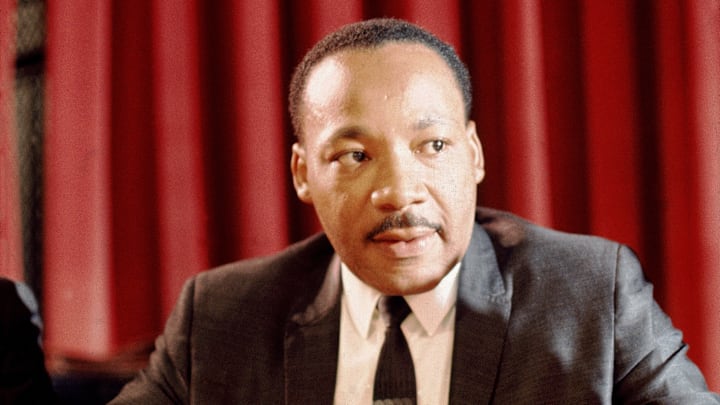On September 20, 1958, Martin Luther King Jr. could be seen calmly sitting in the shoe section at Blumstein’s Department Store with a letter opener protruding from his chest and a blood stain blooming across his white shirt.
King had come to the store in Harlem, New York, to sign copies of his book Stride Toward Freedom, about the Montgomery Bus Boycott. The event had gone smoothly until a well-dressed woman jumped the queue and, after confirming the author was indeed King, sunk the blade several inches into his sternum. A security guard and a newspaper reporter managed to catch the culprit before she could flee, and the crowd quickly devolved into panic. King himself did not. “That’s all right,” he said. “Everything is going to be all right.”
Close Call
The immediate issue at hand was whether to remove the blade sticking out of King's chest before he was taken to the hospital. One woman gave up after slicing her fingers on its edges, and everyone ultimately decided to leave the job to the doctors. That decision may have saved King’s life, though nobody knew it at the time. “It was a miracle that no one removed the blade,” chief surgeon Dr. Aubré de Lambert Maynard later said.
As History.com reports, an ambulance finally arrived and transported King to Harlem Hospital, where he spent more than two hours in the operating room. In addition to Maynard, his main surgeons were Dr. Emil Naclerio, a first-generation Italian American, and Dr. John W.V. Cordice Jr., a former physician for the Tuskegee Airmen. The surgeons quickly realized the letter opener was so close to King’s aorta that simply pulling it out of the existing hole wasn’t an option. Instead, they withdrew two of King’s ribs and slid the weapon out that way.
After the procedure, Naclerio explained just how dire the situation had actually been. “Had Dr. King sneezed or coughed, the weapon would have penetrated the aorta. He was just a sneeze away from death,” he said, according to Jet magazine.
A Sympathetic Victim
As King lay convalescing in his hospital bed, his assailant was identified as 42-year-old Izola Ware Curry, who believed King and other civil rights activists had personally conspired against her and also colluded with communists. Authorities deemed her not competent to stand trial, and she was committed to a psychiatric institution after being diagnosed with paranoid schizophrenia on October 20. Days later, a recovered King alighted at the airport in Montgomery, Alabama, and expressed his sympathy for Curry.

“I can say, in all sincerity, that I bear no bitterness toward her and I have felt no resentment from the sad moment that the experience occurred,” King told the crowd. “I know that we want her to receive the necessary treatment so that she may become a constructive citizen in an integrated society where a disorganized personality need not become a menace to any man.”
King’s main takeaway from the experience was a reinforced commitment to promoting nonviolence. Meanwhile, Naclerio’s “a sneeze away from death” comment reverberated through the minds of his supporters. “I'm simply writing you to say that I’m so happy that you didn't sneeze,” one high school student told King in a letter.
On April 3, 1968, the day before his assassination, King delivered what would be his last speech ever at a temple in Memphis, Tennessee. In it, he referenced that letter before enumerating a list of civil rights events he would have missed if he had sneezed. “I’m so happy that I didn’t sneeze,” he said.
Read More About History:
A version of this story ran in 2021; it has been updated for 2025.
